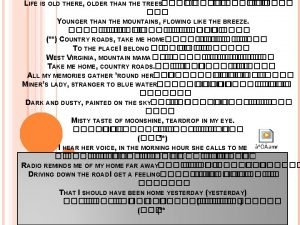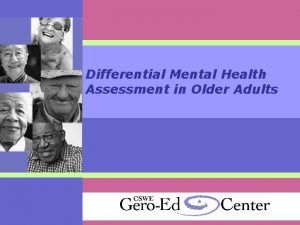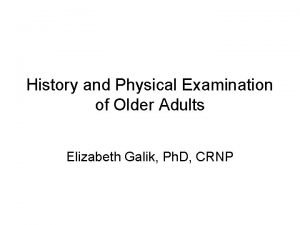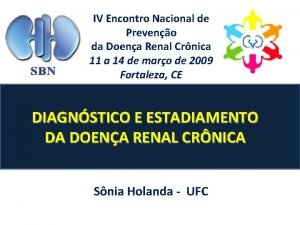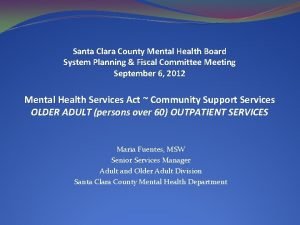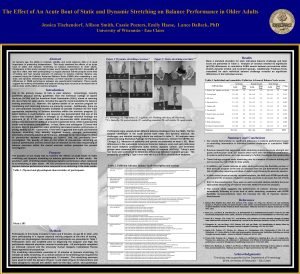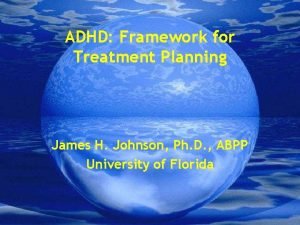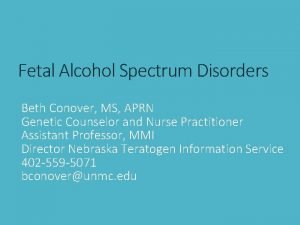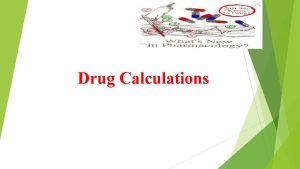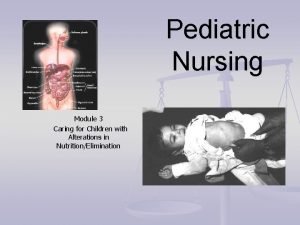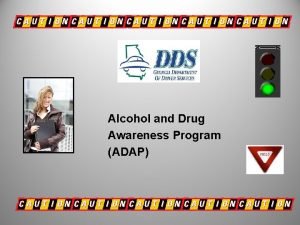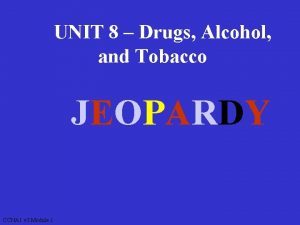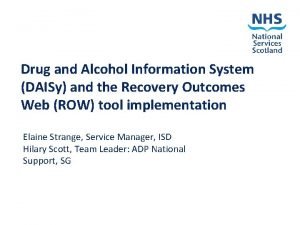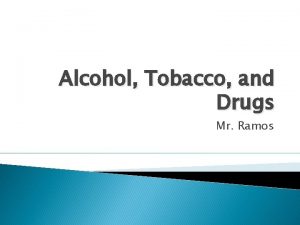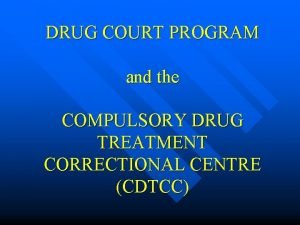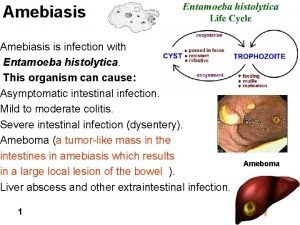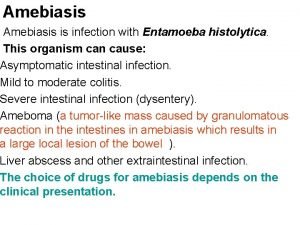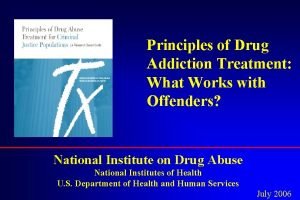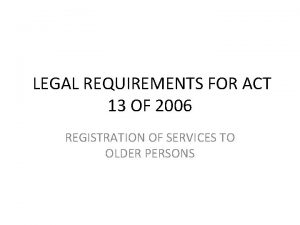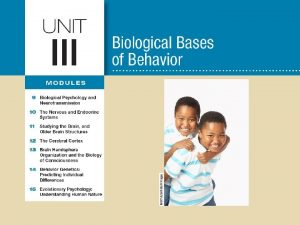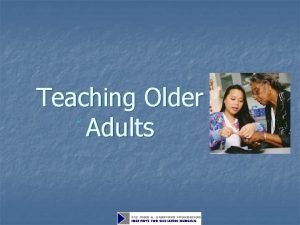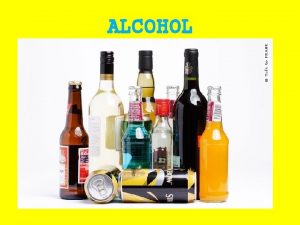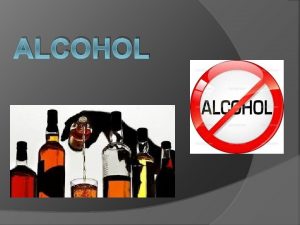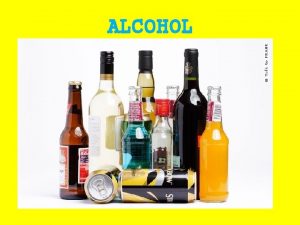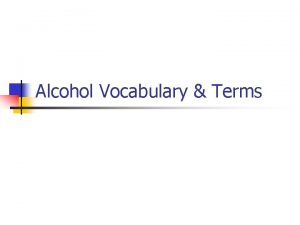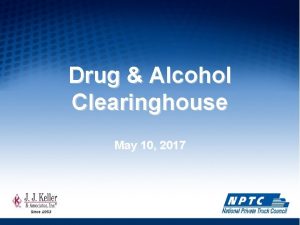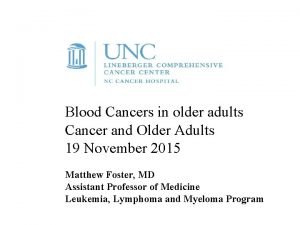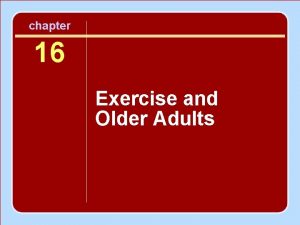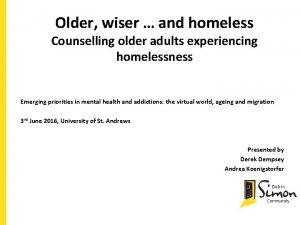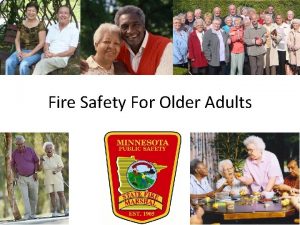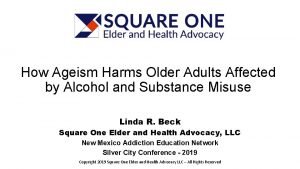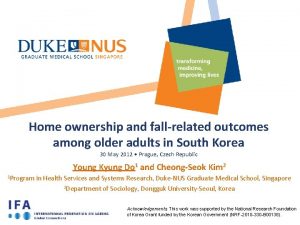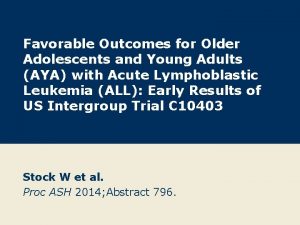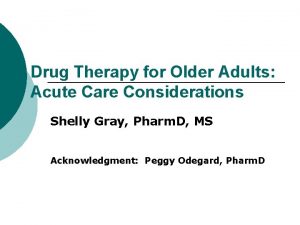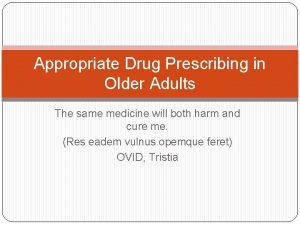Drug and Alcohol Treatment Outcomes in Older Adults


































- Slides: 34

Drug and Alcohol Treatment Outcomes in Older Adults Derek D. Satre, Ph. D. Jennifer Mertens, M. A. Sujaya Parthasarathy, Ph. D. Constance Weisner, Dr. PH. , M. S. W. University of California, San Francisco and Kaiser Permanente Division of Research

Study Support Studies were supported by the National Institute on Drug Abuse (R 01 DA 08728 and R 37 DA 10572) and the National Institute on Alcohol Abuse and Alcoholism (R 37 AA 10359). The first author was supported by a National Institute on Drug Abuse training grant (T 32 DA 07250) and center grant (P 50 DA 09253). The Drug and Alcohol Research Team at the Kaiser Division of Research and the staffs of the Kaiser Chemical Dependency Recovery Programs provided essential support for these studies.

Key Older Adult Treatment Research Gaps • • • Clinical needs of older adults in treatment Studies of private programs Factors associated with treatment success Gender differences Long term outcomes Cost impacts

Research Questions • How are older patients different from others at baseline and at 6 -month follow-up? • How do older patients differ by gender? • How are 5 -year outcomes of older adults in treatment different from those of other patients? • How do health service utilization and cost offset associated with treatment differ by age group?

Sample • 1204 patients at Kaiser completed CD treatment intakes at outpatient facilities in Sacramento, from 1994 to 1996. (Day Hospital Study) -Weisner et al. , 2000 • Drug testing was used to validate self-report • 80% of patients completed six-month follow-up • response rate increased with age: 77% of younger, 83% of middle-aged, and 91% of older adults

Treatment Program • Randomized to day hospital outpatient or lower-intensity outpatient care • Abstinence-based, 12 -step informed, group format included education, relapse prevention and family-oriented therapy • Individual counseling and physician appointments were available as needed

Theoretical Framework for Analyses • Treatment outcome is determined by • Individual characteristics • Treatment • Extra-treatment factors • How are older adults different from other patients in these domains that influence outcome?

Analyses • Compared three age groups: • 736 patients ages 17 -39, mean age = 30. 4 (sd = 6. 3) • 379 patients ages 40 -54, mean age = 45. 1 (sd = 3. 8) • 89 patients ages 55 -81, mean age = 61. 6 (sd = 6. 0) • Examined gender differences within the older adult group • Tested predictors of abstinence using logistic regression

Key Baseline Age Differences • Older adults (55 -81): • Married, Caucasian, retired • ASI score means (vs. younger adults): • Higher alcohol severity • Lower drug severity • Greater medical problems • Fewer social and family problems • Less psychiatric distress (ASI and SCL-66) • More likely to have abstinence goal -Satre et al. , 2003

Length of Stay in Treatment • Treatment length was measured in days • Older and middle-aged stayed longer than younger, p <. 001

Abstinence Rates at Six Months • Significant overall age group differences, p =. 03

Factors Associated with Greater Age, and with Abstinence at Six Months • • • Being married* Dependence criteria not met* Less hostility on SCL-66* Abstinence goal*** Greater length of stay*** (Age was NS)

Implications • Older adults bring several strengths to treatment that younger adults lack, such as lower hostility and greater abstinence motivation, and they stay in treatment longer • However, these advantages do not translate into substantially higher abstinence rates

Why Study Older Women? • • Fastest growing segment of the population Heavy users of health services Concerns about prescription drug use May be more sensitive to alcohol or drugs than men • May have different treatment needs and access issues

Gender Differences in Six-Month Outcome • N = 92 (29 women and 63 men) • Alcohol dependent adults age 55 and over • Data drawn from two outcome studies (Day Hospital Study and Integrated Care Study) to increase sample size -Weisner et al. , 2000, 2001.

Baseline Characteristics of Older Women versus Older Men • • Lower income (53% vs. 33% earn under 40 K)* Not married (38% vs. 62% married)* Later onset of heavy drinking (5+) (age 35 vs. 28)* Comparable baseline alcohol consumption (16 days per month of 5+ drinks) • Comparable tranquilizer use (25% vs. 29%) • Perhaps more distress (78% vs. 60% anxiety, NS) • Comparable abstinence goal (100% vs. 90%) -Satre et al. , 2004 a

Length of Stay by Gender • Older women stayed an average of 24 days longer in treatment than older men (NS)

Abstinence at Six Months by Gender • 79% of older women abstinent at six months, vs. 54% of older men (p <. 05)

Clinical Implications for Older Women • Strengths • Abstinence goal • Length of stay • Good abstinence outcomes • Special needs • Social support (living alone) • Economic support • Depression and anxiety treatment

Day Hospital Sample at Five Years • 77% of the sample completed 5 -year followup • Older adults more likely to maintain Kaiser membership (91% vs. 80%, 59%) • Mortality by age group: • 1% of younger • 5% of middle-aged • 11% of older -Satre et al. , 2004 b

Five Year Outcomes • Older adults had lower legal and family/social ASI scores than younger adults • No difference on other ASI scores • Higher 30 -day and 1 -year abstinence rates than younger adults (all substance diagnoses) • No age difference in abstinence among those only dependent on alcohol

30 -day Abstinence Rates at Five Years by Age Group • Significant overall age group differences, p =. 02

30 -day Abstinence at Five Years by Age and Gender

Age Differences in Social Networks Younger Married (%)*** 39 AA groups in past 89 (96) Middle 54 93 (99) Older 59 61 (77) Ever called AA for 47 help (%)*** Recovery helpers 8 (11) 42 19 9 (13) 5 (8) Encourages use (% 17 saying yes)* 12 8 Kaiser coverage** 59 80 91 12 months

Predictors of Abstinence at Five Years • • Female gender** Length of stay*** Nobody encouraged drinking or drug use*** Not significant • Age group • CD diagnosis • Treatment intensity • Married at year five • Kaiser membership at year five

Five-Year Study Key Points • Older women have the best outcome • Greater length of stay in treatment has longterm benefits • Older adults show strengths and weakness in social networks

Proposed Intervention • Based on profile of social networks • Lower AA use in older adults • Activate or expand informal support • Supplement mixed-age program • Age-specific interpersonal psychotherapy group (K award study)

Medical Conditions • Study compared CD patients in treatment to demographically matched control from the Kaiser membership • One third of medical conditions examined were more prevalent in CD patients, especially: • Hypertension, liver cirrhoses, COPD, asthma, injuries, lower back pain, arthritis, headache, depression, anxiety, psychosis -Mertens et al. , 2003

Medical Conditions in Patients Age 55 and Over • CD patients had higher rates than age- and sex-matched controls: • Ischemic heart disease • Depression • Anxiety

Health Care Utilization and Cost • Records of CD patients were examined 18 months pre- and post-intake • Compared to utilization and cost records in a non-patient control group, using automated health plan records • Examined age group differences -Parthasarathy et al. , 2001

Utilization and Cost Findings • Greater age was positively associated with pre-treatment cost in both samples • Post-treatment, decline in cost was larger in the treatment sample than in the matched sample for those aged 40 to 49, but not in older age groups

Areas for Further Investigation in Older Adults • Improving outpatient CD treatment • Social network intervention • 9 and 11 year Day Hospital study follow-up • Remission, alcohol vs. drug use • How CD (and treatment) affects health • Health conditions and psychiatric disorders • Services utilization and cost • Primary care study • Dual diagnosis study funded by RWJF

References • Mertens, J. R. , Lu, Y. W. , Parthasarathy, S. , Moore, C. , & Weisner, C. (2003). Medical and psychiatric conditions of alcohol and drug treatment patients in an HMO. Archives of Internal Medicine, 163, 2511 -2517. • Parthasarathy, S. , Weisner, C. , Hu, T. W. , & Moore, C. (2001). Association of outpatient alcohol and drug treatment with health care utilization and cost: Revisiting the offset hypothesis. Journal of Studies on Alcohol, 62, 89 -97. • Satre, D. D. , Mertens, J. R. , Areán, P. A. , & Weisner, C. (2003). Contrasting outcomes of older versus middle-aged and younger adult chemical dependency patients in a managed care program. Journal of Studies on Alcohol, 64, 520 -530. • Satre, D. D. , Mertens, J. R. , & Weisner, C. (2004 a). Gender differences in older adult treatment outcomes for alcohol dependence. Journal of Studies on Alcohol, 65, 638 -642.

References (cont. ) • Satre, D. D. , Mertens, J. R. , Areán, P. A, & Weisner, C. (2004 b). Five- year alcohol and drug treatment outcomes of older adults versus middleaged and younger adults in a managed care program. Addiction, 99, 1286 -1297. • Weisner, C. , Mertens, J. , Parthasarathy, S. , Moore, C. , Hunkeler, E. M. , Hu, T. -W. & Selby, J. V. (2000) The outcome and cost of alcohol and drug treatment in an HMO: day hospital versus traditional outpatient regimens. Health Services Research, 35, 791 -812. • Weisner, C. , Mertens, J. , Parthasarathy, S. , Moore, C. , & Lu, Y. (2001) Integrating primary medical care with addiction treatment: a randomized controlled trial. Journal of the American Medical Association, 286, 17151723. Contact: Derek Satre, Ph. D. , UCSF, 401 Parnassus, Box 0984 -OVS, San Francisco, CA 94143. Email: dereks@lppi. ucsf. edu
 Life is older than the trees
Life is older than the trees Mental health and older adults
Mental health and older adults Mental health and older adults
Mental health and older adults Altered cognition in older adults is commonly attributed to
Altered cognition in older adults is commonly attributed to Conclusion of physical examination
Conclusion of physical examination Older adults
Older adults Covids older adults
Covids older adults Older adults mental health
Older adults mental health Dynamic stretching for older adults
Dynamic stretching for older adults Adhd goals and objectives examples
Adhd goals and objectives examples Fas adults
Fas adults Oral medication calculation formula
Oral medication calculation formula Pyloric stenosis surgery
Pyloric stenosis surgery Arch drug and alcohol service
Arch drug and alcohol service Tadra is an acronym for georgia's
Tadra is an acronym for georgia's 12 core functions substance abuse
12 core functions substance abuse Drug and alcohol jeopardy
Drug and alcohol jeopardy Drug and alcohol information system (daisy)
Drug and alcohol information system (daisy) Centre county drug and alcohol
Centre county drug and alcohol What effect might alcohol and another drug
What effect might alcohol and another drug Drug and alcohol safety training
Drug and alcohol safety training Formation of alcohols
Formation of alcohols Primary alcohol secondary alcohol
Primary alcohol secondary alcohol Concentration of alcohol
Concentration of alcohol Why is alcohol considered a drug? *
Why is alcohol considered a drug? * Example of crude drug adulterated with exhausted drug
Example of crude drug adulterated with exhausted drug Compulsory drug treatment correctional centre
Compulsory drug treatment correctional centre Drug reaction treatment
Drug reaction treatment Drug of choice for the treatment of extraluminal amebiasis
Drug of choice for the treatment of extraluminal amebiasis Drug of choice for the treatment of extraluminal amebiasis
Drug of choice for the treatment of extraluminal amebiasis Principles of drug addiction treatment
Principles of drug addiction treatment Taller stronger sister
Taller stronger sister Dq98 form
Dq98 form Downsizing and divesting older business
Downsizing and divesting older business Module 11 studying the brain
Module 11 studying the brain
